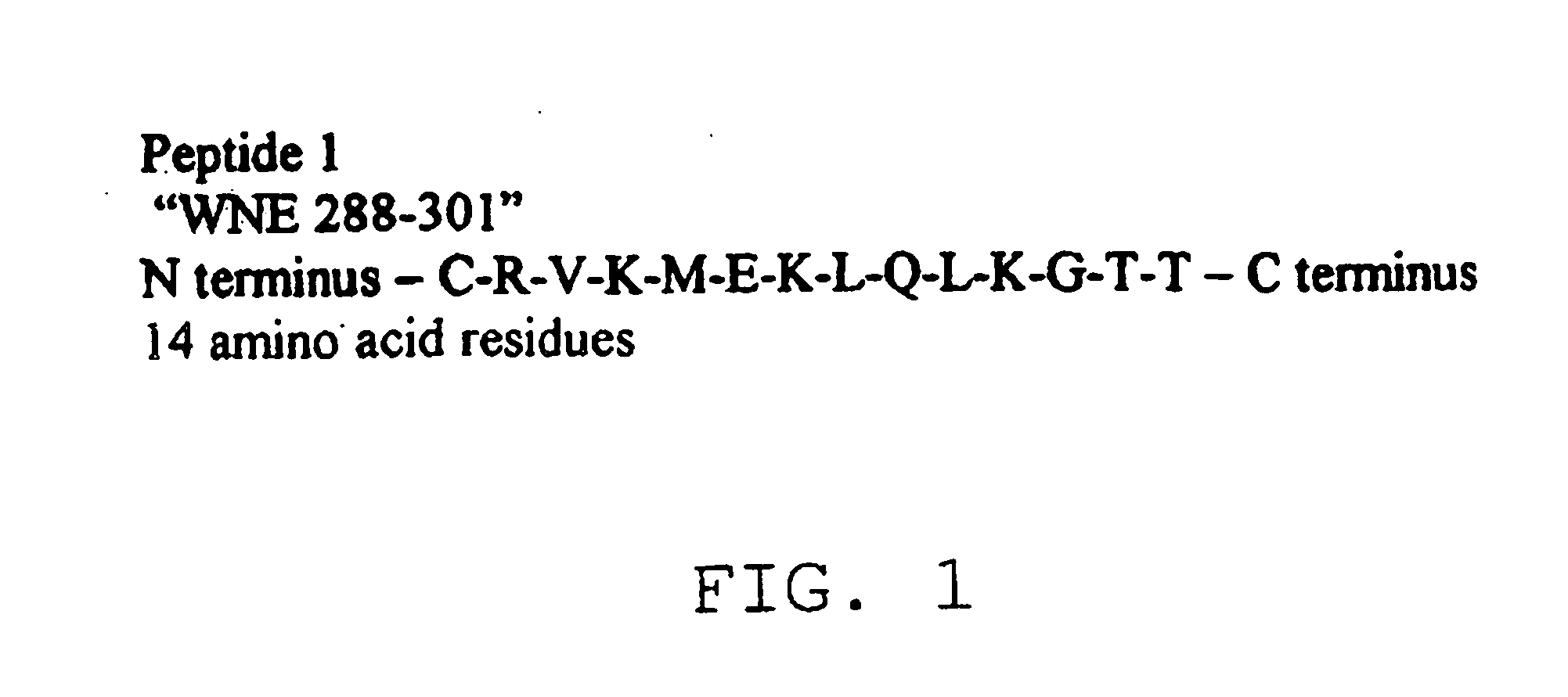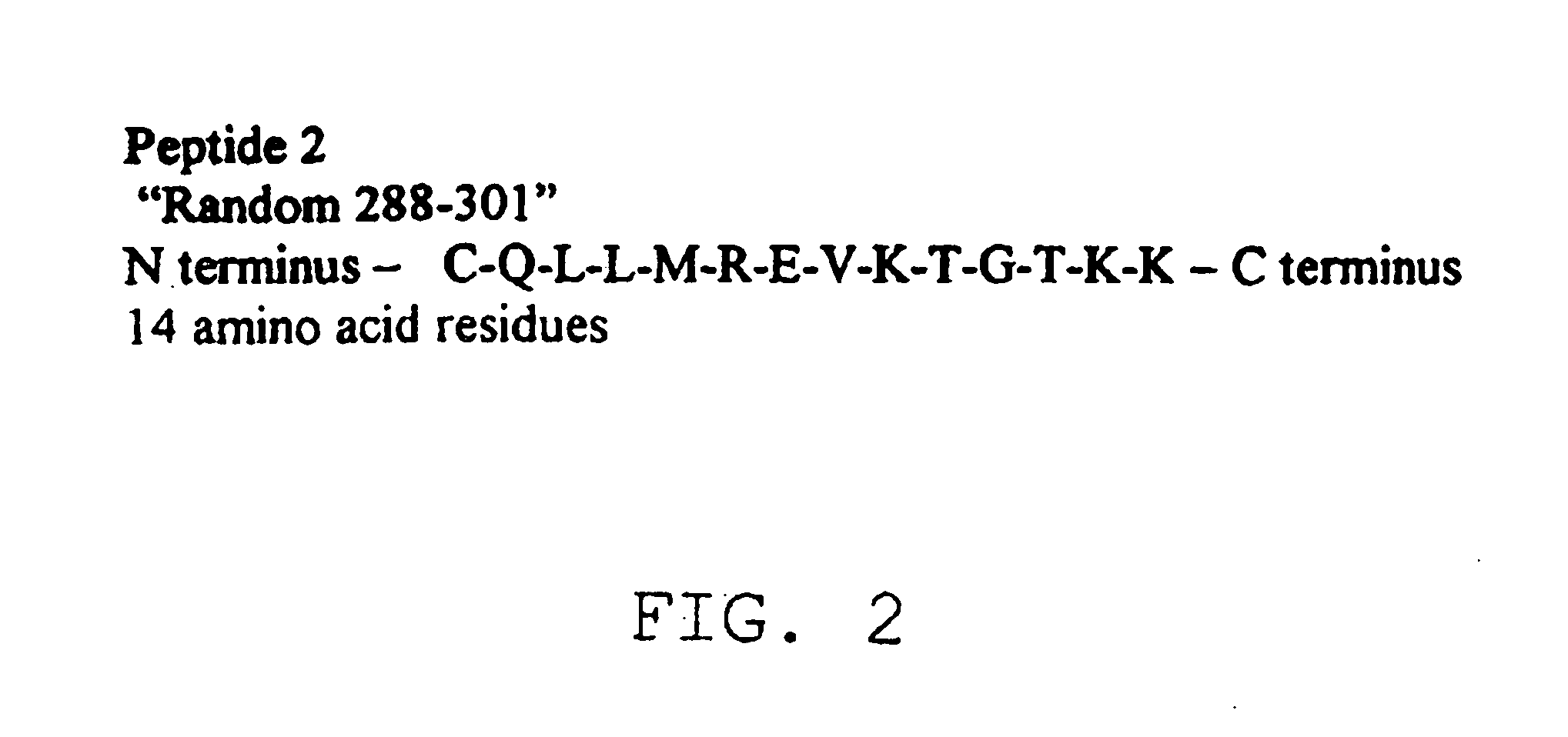Diagnostic test for west nile virus
a technology of diagnostic test and west nile virus, which is applied in the field of diagnostic test for west nile virus, can solve the problems of difficult spraining, toxic to humans, repeated application, etc., and achieve the effects of less expensive, less sensitive, and easy us
- Summary
- Abstract
- Description
- Claims
- Application Information
AI Technical Summary
Benefits of technology
Problems solved by technology
Method used
Image
Examples
example 1
Isolation of WNV in Connecticut
[0391] Several WNV isolates were obtained from mosquitoes and birds in Connecticut. Mosquitoes were captured in dry ice-baited Centers for Disease Control miniature light traps. One mosquito trap was placed at each location per night; the numbers of traps per site ranged from 1 to 6. Mosquitoes were transported alive to the laboratory where they were identified and grouped (pooled) according to species, collecting site, and date. The number of mosquitoes per pool ranged from 1 to 50. The total number of mosquitoes by species that were collected in 14 towns in Fairfield County, Conn., and tested for virus from 6 Sep. through 14 Oct. 1999: Aedes vexans, 1688; Ae. cinereus, 172; Ae. trivittatus, 131; Ae. taeniorhynchus, 123; Ae. sollicitans, 109; Ae. cantator, 63; Ae. triseriatus, 28; Ae. japonicus, 19; Ae. canadensis, 1; Anopheles punctipennis, 82; An. quadrimaculatus, 4; An. walkeri, 2; Coquillettidia perturbans, 15; Culex pipiens, 744; Cx. restuans, 2...
example 2
PCR Amplification of DNA Encoding the Envelope Glycoprotein
[0396] The Connecticut WNV isolate 2741 (GenBank™ Accession No. AF206518), as described Example 1, was grown in Vero cells which were subsequently scraped from the bottom of the flask and centrifuged at 4500×g for 10 min. The supernatants were discarded and RNA was extracted from the pellet using the RNeasy® mini protocol (Qiagen), eluting the column twice with 40 μl of ribonuclease-free water. Two microliters of each eluate was combined in a 50-μl reverse transcription-polymerase chain reaction (RT-PCR) with the SuperScript® one step RT-PCR system (Life Technologies), following the manufacturer's protocol.
[0397] PCR primers, WN-233F (5′-GACTGAAGAGGGCAATGTTGAGC-3′; SEQ ID: 1) and WN-1189R (5′-GCAATAACTGCGGACYTCTGC-3′; SEQ ID: 2) were designed to specifically amplify envelope glycoprotein sequences from WNV based on an alignment of six flavivirus isolates listed in GenBank™ (accession numbers: M16614 (St. Louis encephalitis...
example 3
Expression and Purification of Recombinant WNV Envelope Glycoprotein
[0399] The DNA of Example 2 was expressed in E. coli using the pBAD / TOPO™ ThioFusion Expression System® (Invitrogen). This system is designed for highly efficient, five minute, one step cloning of PCR amplified DNA into the pBAD / TOPO™ ThioFusion expression vector. Fusion protein expression is inducible with arabinose. Fusion proteins were expressed with thioredoxin (12 kDa) fused to the N-terminus, and a C-terminal polyhistidine tag. The polyhistidine tag enables the fusion proteins to be rapidly purified by nickel affinity column chromatography. An enterokinase cleavage site in the fusion proteins can be used to remove the N-terminal thioredoxin leader.
[0400] The pBAD / TOPO ThioFusion Expression System® expression system was used to express and purify WNV envelope glycoprotein encoded by the DNA of Example 2 following the manufacturer's protocol. Specifically, the PCR product obtained as described above was added ...
PUM
| Property | Measurement | Unit |
|---|---|---|
| temperature | aaaaa | aaaaa |
| temperature | aaaaa | aaaaa |
| temperature | aaaaa | aaaaa |
Abstract
Description
Claims
Application Information
 Login to View More
Login to View More - R&D
- Intellectual Property
- Life Sciences
- Materials
- Tech Scout
- Unparalleled Data Quality
- Higher Quality Content
- 60% Fewer Hallucinations
Browse by: Latest US Patents, China's latest patents, Technical Efficacy Thesaurus, Application Domain, Technology Topic, Popular Technical Reports.
© 2025 PatSnap. All rights reserved.Legal|Privacy policy|Modern Slavery Act Transparency Statement|Sitemap|About US| Contact US: help@patsnap.com



